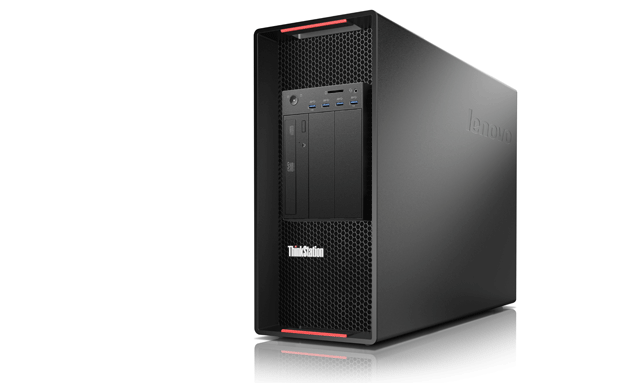
The ThinkStation P900, Lenovo’s brand new ultra high-end dual Xeon workstation, features striking, yet functional, industrial design and impressive expandability
The race to design the ultimate desktop workstation chassis is well and truly on. The industry has long waved goodbye to the noisy grey box with a spaghetti mess of wires inside. Today, it’s all about sleek industrial design (inside and out), tool free serviceability and whisper quiet operation.
As far as Windows-based workstations go, everything changed in 2009 when HP introduced the Z Workstation. This made other vendors sit up and take notice and Dell and Fujitsu responded with their respective Precision T Series and revamped Celsius family. Meanwhile, Lenovo, once a pioneer in workstation chassis design, found itself lagging behind.
Lenovo needed to address this and two years ago embarked on a major project to completely redesign its desktop ThinkStation workstation chassis – one that wasn’t remarkably different to the one it inherited from IBM in 2005.
The result is the brand new ThinkStation P Series, which includes the ultra high-end ThinkStation P900, the high-end ThinkStation P700 and mainstream ThinkStation P500, all of which were unveiled today at Siggraph.
All three machines are due to ship in October to coincide with the launch of Intel’s Haswell-EP Xeon E5 processors, but we were lucky enough to have a sneak preview. And, from our hands on probing, Lenovo certainly looks to be taking the game to its workstation competitors.
The range features an array of user serviceable features, impressive customisation and a highly engineered cooling system. It’s exciting stuff for geeks who like to tinker but also for CAD/CAM/CAE users who want their workstation to grow with their needs or, perhaps more importantly, can’t afford downtime if things go wrong. So let’s have a look at some of the key features.

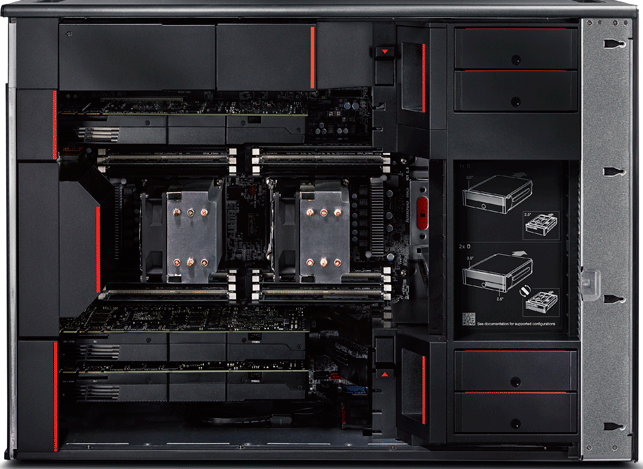
Interior of Lenovo ThinkStation P900 with air baffle (top) and without air baffle (bottom). Red touch points draw the eye to all the components that can be removed and replaced without a too
The Lenovo ThinkStation P Series at a glance
Lenovo ThinkStation P300 (tower)
Entry-level 2D/3D
Single Intel Xeon E3-1200 v3 or Core i7, Core i5, Core i3 CPU
Up to 32GB DDR3 memory
Nvidia Quadro (up to two single width)
Up to four storage devices
175mm x 429mm x 424mm
(Shipped in May 2014)
Lenovo ThinkStation P500
Mainstream CAD/CAM and BIM
Single Intel Xeon E5-1600 v3 or E5-2600 v3 CPU
Up to 256GB DDR4 memory
Nvidia Quadro and Tesla GPUs (up to two double width)
Up to 11 storage devices (8 internal + 2 external + 1 M.2)
175mm x 470mm x 440mm
(Ships in October 2014)
Lenovo ThinkStation P700
High-end CAE and design viz
One or two E5-1600 v3 and E5-2600 v3 CPUs
Up to 384GB DDR4 memory
Nvidia Quadro and Tesla GPUs (up to two double width)
Up to 12 storage devices (8 internal + 2 external + 2 M.2)
175 mm x 470 mm x 440 mm
(Ships in October 2014)
Lenovo ThinkStation P900
Ultra high-end CAE and design viz
Dual Intel Xeon E5-2600 v3 CPUs
Up to 512GB DDR4
Nvidia Quadro and Tesla GPUs (up to three double width)
Up to 14 storage devices (8 internal + 2 external + 4 M.2)
200 mm x 620 mm x 446 mm
(Ships in October 2014)
FLEX appeal
The new ThinkStation P Series is all about flexibility, where each box can be customised to individual user requirements and components chopped and changed throughout the life of the machine.
This manifests itself in four main features, which go under the ‘FLEX’ moniker. There’s some excellent stuff here.
FLEX bay
Today, most optical disc drives (ODDs) are used once in a blue moon so Lenovo has created the FLEX Bay, a front sitting 5.25-inch bay that allows you to drop the ODD in favour of more practical technology.
Additional I/O ports, card readers or storage can all be added to the two or three FLEX Bays that are located at the front of Lenovo’s new machines, alongside four permanent USB 3.0 ports.
The most practical additions are arguably IEEE 1394, PCIe, eSATA or more USB ports. New I/O technologies, such as Thunderbolt, will also be made available next year.
Other FLEX Bay options include a 9-in-one or 29-in-one media card reader and, importantly, front-loading drives.
Putting storage at the front of the workstation makes perfect sense for convenient replacements or upgrades. And, if data security is a concern, it’s also very easy to remove drives for safe keeping overnight, under lock and key.
Of course, with three bays to play with on the ThinkStation P900 and two on the P700 and P500 you can still keep your ODD up front, even swap it out for a slimline drive. The important thing is there’s flexibility should you need it and you can have pretty much anything you want at the front of your machine.
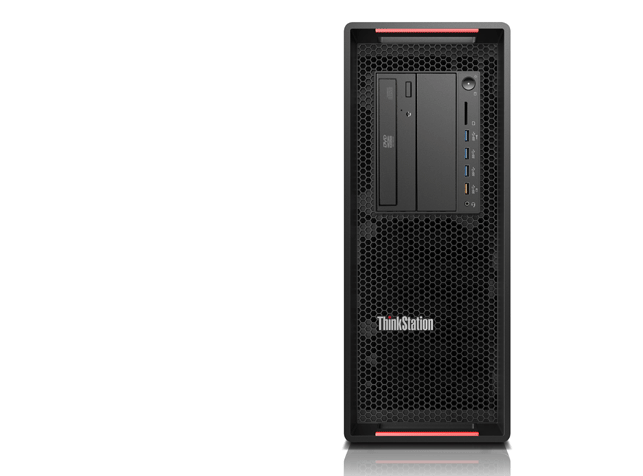
The ThinkStation P700 features two FLEX bays at the front so you can add additional I/O ports or easy access storage as you choose
FLEX connector
Building to its focus on future upgrades, Lenovo has also introduced the FLEX connector, a bespoke, small footprint PCIe card that slots into the motherboard, in a different location to the standard PCIe slots.
The main idea is users can add new workstation technologies without having to take up a full size PCIe slot.
Lenovo currently offers a RAID, I/O expansion (PCIe, USB and SATA), or fast M.2 storage adapter, with can host two 256GB or 512GB SSDs. Others will follow, including new I/O technologies like Thunderbolt. Cables are routed to ports in the front FLEX Bays.
The FLEX connector is a nice idea, and one that will certainly appeal to high-end users who have compute-intensive CAE or rendering workflows. Here, demand for PCIe slots can be high and some users max them out by hosting multiple GPU compute boards (Nvidia Tesla) or high-performance Fusion I/O storage.
Lenovo says FLEX connectors will not only give users more flexibility but will mean they won’t be burdened with the cost of technologies that they might not necessarily need.
The ThinkStation P900 can support two FLEX connectors; the P700 and P500 one.

Interior of a ThinkStation P900. The FLEX Connector in blue (top right) allows new workstation technologies to be added without having to take up a full size PCIe slot. Here six slots are already taken with three double width Quadro GPUs
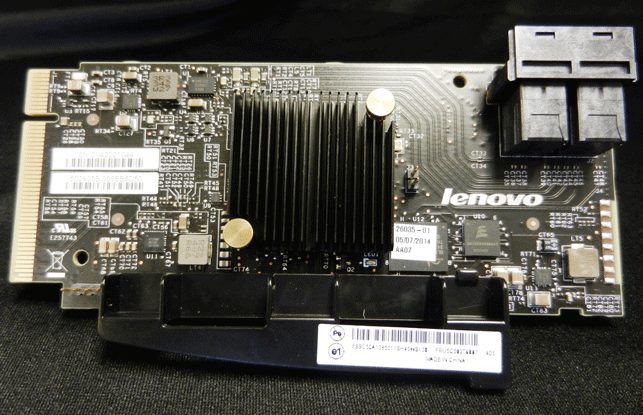
FLEX Connector 1: RAID card
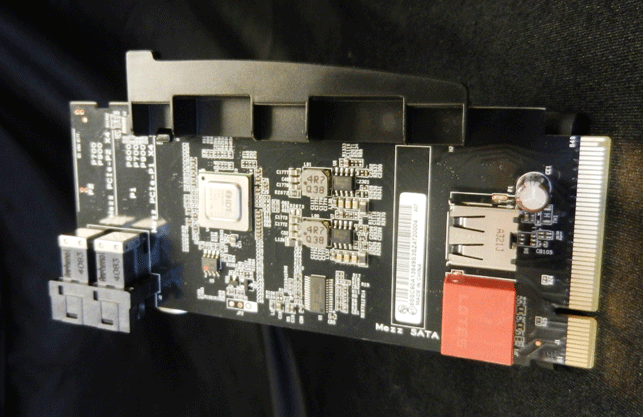
FLEX Connector 2: PCIe, USB and SATA expansion card to help add new or additional I/O ports at the front of the machine
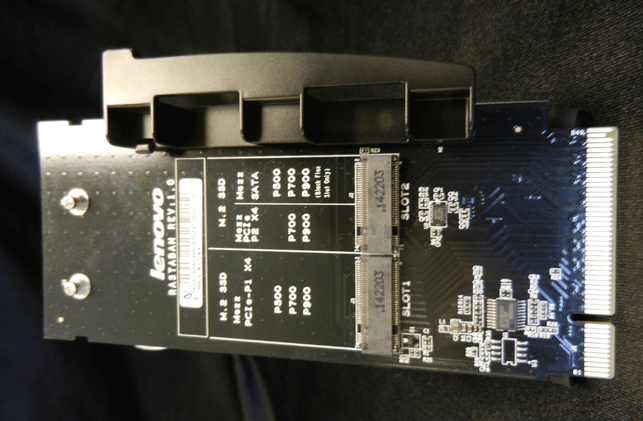
FLEX Connector 3: M.2 expansion card for superfast PCIe speed SSDs
FLEX Drive Trays
This is more standard fare for a workstation chassis and allows users to add and remove hard drives without having to reach for a screwdriver.
Each FLEX Drive tray can host a single 3.5-inch drive or two 2.5-inch drives, which clip neatly into position inside each tray. Once the drive(s) are in place the whole tray simply slots into the chassis, pushing up against a back plane to automatically connect to power and data. There’s not a cable in sight.
Strangely, the top-end ThinkStation P900 is the only model to come with this ‘blind connect back plane’ as standard, though it is an option on the ThinkStation P500 and ThinkStation P700.
The beauty of Lenovo’s FLEX Drive trays is they are all identical, even across the different P Series models. This makes it very easy for enterprises to manage a whole range of machines.
All systems come fully populated with drive bays so you can update to the maximum number of supported drives whenever you want.
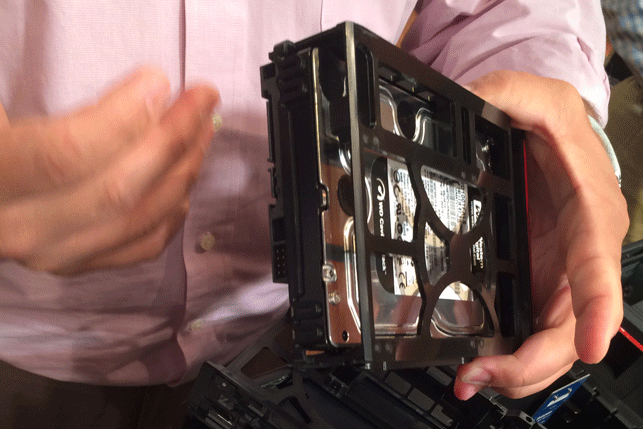
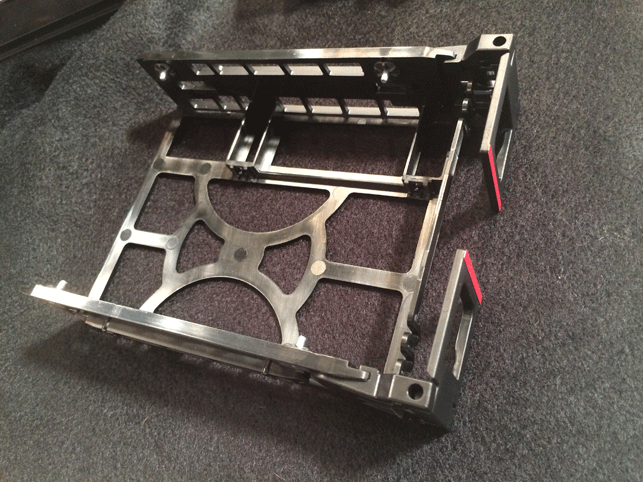
The FLEX Drive tray, which is standard across the entire ThinkStation P Series, can host one 3.5-inch drive or two 2.5 drives including a choice of HDD, SSD, and SAS drives
FLEX Power
This is another common feature in modern workstations – a power supply unit (PSU) that can be swapped out in a matter of seconds. Simply pull on the red lever and out it comes.
In years gone by a failed PSU could take hours to replace, as the many power cables coming off it would need to undone and re-routed as they were permanently connected to the PSU.
The PSU truly earns its ‘FLEX’ status in the ThinkStation P500 and P700, where users have the choice of three models. Each comes with its own power rating – 490W, 650W or 850W – to serve different types of users, but all have the same form factor. With all the customisation available in the machine, from CPUs and GPUs to storage and memory, there can be a big difference in wattage requirements.
Lenovo says this tiered approach not only saves cash at time of purchase but also can reduce ongoing energy costs as you get a more efficient power delivery system.
While the ThinkStation P500 and P700 offer huge flexibility, the P900 is all about ultra high-end performance so the PSU is fixed at 1300W. It does pull out just as easily though.
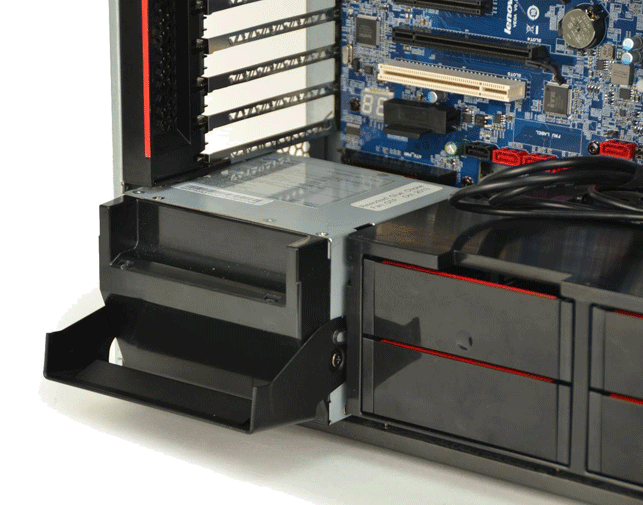
All power supply units can be replaced with ease and the ThinkStation P500 and P700 come with a choice of three PSUs (490W, 650W or 850W) to directly match workstation components to wattage
Body language
With the ThinkStation P Series Lenovo has delivered a new bold design. It’s minimal yet still functional, with the industrial design team placing two handles at the front and one at the back to make it easy to move or load into racks.
For a machine that can weigh up to 35kg fully loaded this was a must, says Lenovo. The inspiration came from a beer keg, we are told. One can only imagine its design team spends a lot of time down the pub.
Unlike previous ThinkStation generations, the handles are totally integrated into the main body of the chassis, instead of sticking out at the top of the machine. This certainly makes for a more elegant design.
Other elements of the design have also evolved. The honeycomb grille – which Lenovo says is the most efficient shape for moving air through a membrane – helps retain the ThinkStation’s classic identity. However, instead of being flush with the front façade it’s now recessed a little.
But perhaps the biggest innovation is inside the box. Pull off the side panel and you can immediately see the influence of Lenovo’s industrial design team inside.
Red touch points throughout the interior draw the eye to all the components that can be removed and replaced without ever reaching for a tool. This not only includes drives and PCIe cards, but the PSU, fans and even the motherboard can all be removed and replaced incredibly easily. In fact, the only components that do require a tool are the CPU heat sinks.
Cool runnings
Like most manufacturers, Lenovo is very serious when it comes to keeping its workstations running cool. Carefully managing airflow inside the machine not only reduces fan noise but also improves system reliability as components aren’t stressed as much, says Lenovo.
The ThinkStation P-Series is said to run cooler than Lenovo’s previous generation thanks to a brand new thermal design, which builds on the tried and tested principle of drawing in cool air at the front of the workstation and expelling it from the back.
Lenovo has extended its patented tri-channel cooling technology, which as the name suggests, breaks down the cooling into three distinct sections. Each has a dedicated fan.
In the ThinkStation P900 the top fan takes care of the top two drive bays, the PSU and the top PCIe cards. The bottom fan cools the bottom two drive bays and other PCIe cards.
The middle fan handles the front FLEX bays, plus the CPUs and memory. There’s also a large 120 x 38mm fan at the rear that helps pull warm air through that central section so it doesn’t heat other components.
It’s in this central part of the case that things get quite clever. With two 160W Xeon CPUs, each featuring up to eight dedicated memory banks, it’s important that each processor is given equal attention. In other systems the secondary CPU might get second hand air warmed by the primary CPU.
To engineer this Lenovo developed a complex passive, bifurcated air baffle that features a series of ducts to route dedicated cool air over each CPU and each lane of memory DIMMS. The plastic unit, which clips into place, goes all the way down to the motherboard to help ensure air doesn’t leak out and flows exactly where it is supposed to.
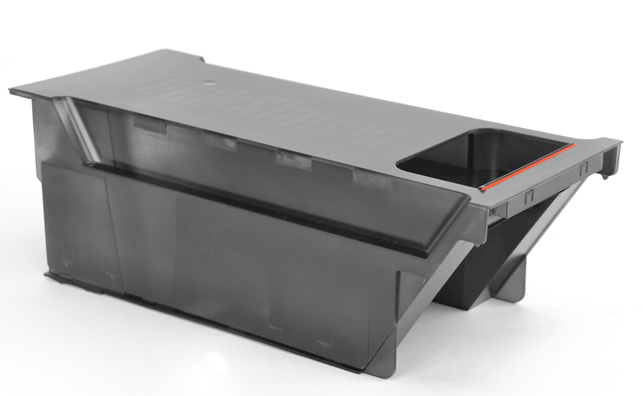
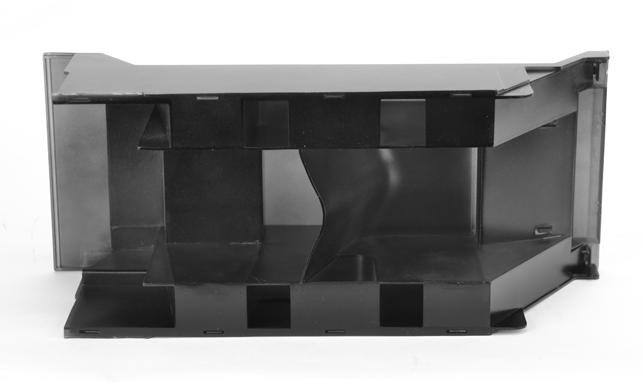
The ThinkStation P900’s bifurcated air baffle features a series of ducts to route dedicated cool air over each CPU and each lane of memory DIMMS
Lenovo is very proud of the fact that it manages to cool the entire workstation with only four fans – even one that is fully loaded with high-spec components. It says some competitors can use up to ten fans, adding to the number of possible failure points.
Should there ever be a fan failure, replacements take a matter of seconds. With blind mate connectors, you simply pull one out and slot another in. This also makes cleaning out dust and fluff very easy.
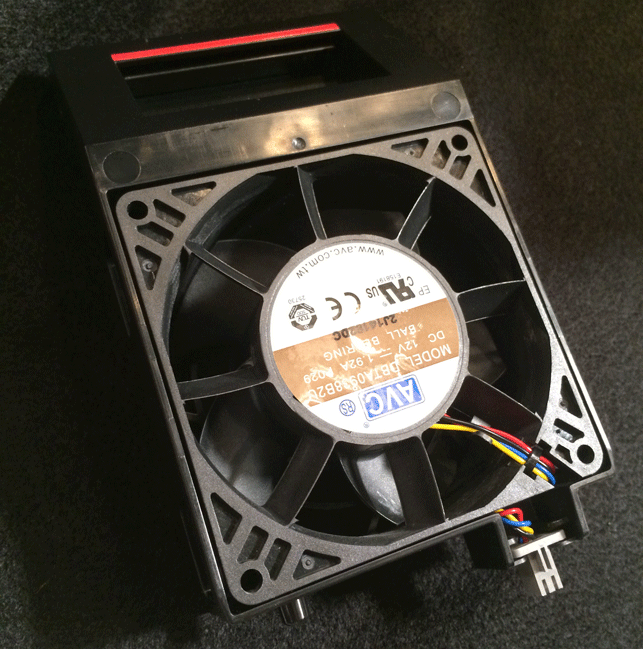
Service in seconds: the ThinkStation P900 fan with a red touch point (top) to pull out and blind connector (bottom) to automatically connect to power
The P Series models
With the introduction of the ThinkStation P Series Lenovo has tweaked the positioning of its workstation line up a little.
The dual CPU ThinkStation P900 is the replacement for the ThinkStation D30 but with new levels of expandability it addresses what Lenovo describes as the ultra high-performance sector, catering for oil and gas customers as well as users of CAE software. This will probably include high-end design viz users as well, though Lenovo does not state this explicitly.
Standout features include the ability to support three double width PCI Express GPUs, such as the Nvidia Quadro K6000 or Tesla K40, as well as a single width GPU.
With 16 DIMM slots, there’s capacity for 512GB RAM, rising to 1TB when 64GB DIMMs become available later this year. There’s also room for a ridiculous number of storage devices (14) including up to four high-speed M.2 SSDs that slot into two FLEX connectors.
The dual CPU ThinkStation P700 now covers the whole of the traditional high-end market. This means there no like for like replacement for the ThinkStation C30, Lenovo’s much loved compact dual CPU workstation.
The C30 stood out from the crowd because of its impressive slimline chassis but because Lenovo wanted to standardise components in the P Series, including the FLEX Drive bays, it had to drop this non-standard form factor.
The ThinkStation P700 takes things down a notch in terms of expandability, but there’s still plenty of capacity. It can host two double width GPUs, up to 384GB RAM (rising to 712GB with 64GB DIMMs) and up to 12 storage devices. There’s only support for one FLEX connector in this case (meaning a maximum of two M.2 SSDs) and two FLEX bays.
The single CPU ThinkStation P500 shares the same chassis as the P700 but the specs are brought down a notch. In addition to only supporting a single CPU, there are only 8 DIMM slots and two PCIe x 16 slots.
Storage is still plentiful (up to 10 x 2.5-inch drives and 6 x 3.5-inch drives) but there’s only room for one 256GB SSD in the M.2 FLEX Connector.
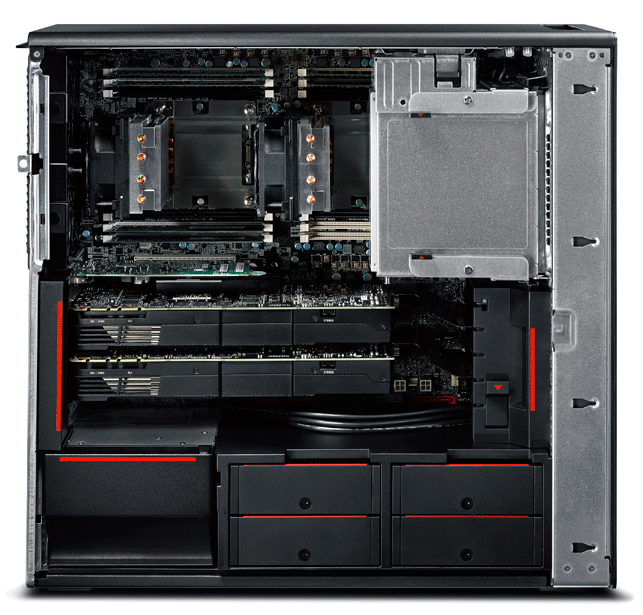
Interior of the ThinkStation P700 with four FLEX Drive Bays and interchangeable PSU at the bottom
Softly does it
In addition to hardware, Lenovo has also revamped its supporting software, to both optimise performance and improve error reporting.
Considering the success of the HP Performance Advisor and Dell Precision Performance Optimizer (DPPO) the fact that Lenovo has introduced its own Performance Tuner comes as little surprise.
The idea is the software helps users monitor system resources and tune their machine for different workflows, based on the nuances of specific applications.
At launch, Lenovo will provide preset application profiles for a number of systems including AutoCAD, Maya, SolidWorks and 3ds Max, but will add to those over time. It will also allow users to create their own profiles, controlling things like Intel HyperThreading, number of CPU cores, graphics driver settings or shutting down background apps.
We’ve not seen this software in the flesh yet but from discussions with Lenovo it seems to be at a relatively early stage of development. At launch, system changes won’t be dynamic. Instead it will detect when you run a specific application and recommend changes that need to be made manually. Automation will come shortly after, says Lenovo.
Lenovo Mobile diagnostics is another new software tool, designed to make it easier to understand and report errors.
With most workstations, if you have an error on the system you get a four-digit code, which typically requires you to punch it into Google or look it up in a manual.
With Lenovo Mobile diagnostics the ThinkStation has a dedicated, always on, USB port on the front of the machine that enables the error log to be downloaded to an Android or Windows phone or tablet or a USB stick. It reports errors in plain English, ranks them in order of severity and also makes it easy to share this information with tech support.
Lenovo also puts QR Codes on its ThinkStation component, which users can scan to find detailed information about technical specifications.
Conclusion
Lenovo has really gone to town with its ThinkStation P Series and our first impressions are very positive indeed. The chassis looks to be extremely well designed, inside and out, airflow and acoustics well refined and there’s an incredible amount of customisation that can go on inside the machine. But therein lies a challenge.
Some customers are sure to invest time, carefully choosing the best combination of components, FLEX and non-FLEX, while others may find the matrix of options quite bewildering.
Lenovo is onto this though and will be updating its web-basic configurator to help customers wade through the choices. And for customers that don’t necessarily care about customisation and simply want a good looking, quiet machine, it will also be promoting key SKUs (Stock Keeping Units) on a country-to-country basis to hit different sweet spots.
We look forward to getting hands on with the new ThinkStation W Series in the autumn.
Read our hands-on, in-depth review of the Lenovo ThinkStation P500






